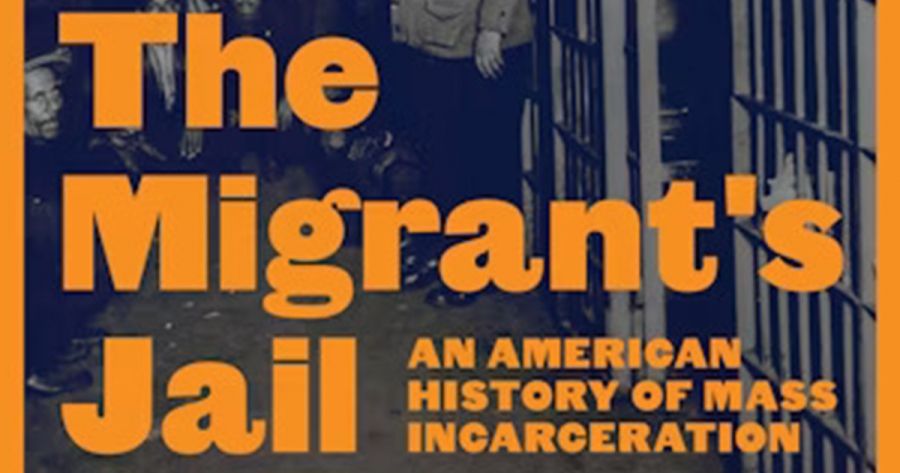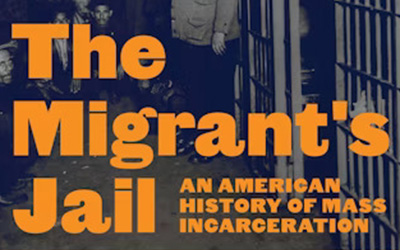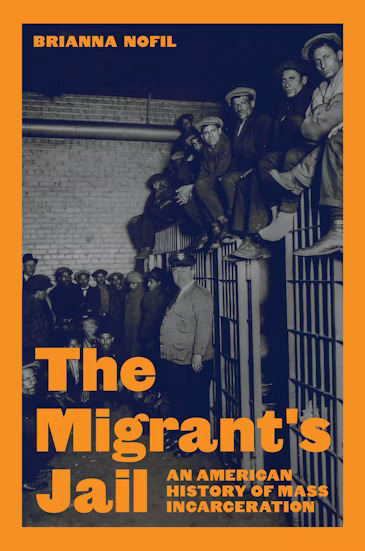
- Free Article: No
- Contents Category: United States
- Review Article: Yes
- Article Title: The carceral state
- Article Subtitle: A deep history of migrant imprisonment
- Online Only: No
- Custom Highlight Text:
How can a self-proclaimed nation of immigrants,’ asks Brianna Nofil, the author of The Migrant’s Jail, ‘also be a place that imprisons tens of thousands of immigrants, exiles, and refugees?’ In answering that question, Nofil, an assistant professor of history at William and Mary, researches the history of the crucial role of local county jails and their widespread deployment by the federal government to build the largest migrant detention and deportation system in the world. Incarceration was the prelude to deportation.
- Featured Image (400px * 250px):

- Alt Tag (Featured Image): Marilyn Lake reviews ‘The Migrant’s Jail: An American history of mass incarceration’ by Brianna Nofil
- Book 1 Title: The Migrant’s Jail
- Book 1 Subtitle: An American history of mass incarceration
- Book 1 Biblio: Princeton University Press, $57.99 hb, 336 pp
- Book 1 Cover Small (400 x 600):

- Book 1 Cover (800 x 1200):

- Book 1 Readings Link: https://www.readings.com.au/product/9780691237015/the-migrants-jail--assistant-professor-of-history-brianna-nofil--2024--9780691237015#rac:jokjjzr6ly9m
While those who survived the ‘uniquely dire conditions of US local jails’ have insisted that this is their history, and that it should be more widely known, Nofil insists that Americans need to acknowledge this shameful past as part of their national story. But of course it is not yet past. Under the new Trump administration, the system of incarceration and deportation of unwanted migrants has been reinvigorated with a vengeance. Donald Trump made the ‘mass deportation’ of ‘illegal immigrants’ – now conceptualised as ‘enemy aliens’ – a key plank in his nationalist program of ‘Make America Great Again’.
Since the nineteenth century, American federal governments have determined immigration policy, but they paid and depended on local authorities to implement it – there were no federal prisons before 1895 – which prompted the proliferation of local places of immigrant incarceration across the country. In many cases, local communities directly profited from unauthorised migration by locking up new arrivals in local jails; detention became a pillar of their economies. As a federation with extensive land and sea borders, the United States became, in Nofil’s words, ‘an interconnected carceral state’.
Trump’s election promise of mass deportation, though seemingly radical, rests on long-established American practice. For many decades asylum seekers and unauthorised arrivals to the United States have been racialised, demonised, and criminalised – as Asiatics, Mexicans, Blacks, Muslims, Latinos – under ever-changing legislation. Asian exclusion laws in the 1880s were followed by literacy tests and the imposition of national quotas. A 1917 law enabled the deportation of migrants for any criminal activity within five years of arrival. In 1929 the Undesirable Aliens Act criminalised unlawful entry; henceforth illegal entry became a federal crime and detention became state-sponsored punishment. Now Trump intends to invoke the Enemy Aliens Act of 1798, not used since World War II, to deploy the military to detain and deport all arrivals at the southern border, the so-called ‘invasion’ now declared a ‘state of emergency’.
Settler-colonial nations such as the United States and Australia emerged from the displacement and dispossession of Indigenous peoples, while creating national border controls (Australia once had a dictation test) and immigration detention to engineer desired, racially homogeneous, national populations. In such self-styled ‘white men’s countries’, sovereignty was defined in terms of the right to control national borders, the right to say who might come, who might stay, and who must leave. As John Howard famously declared: ‘We will decide who comes to this country and the circumstances in which they come.’ In his inauguration address, Trump restated the theme: ‘Our sovereignty will be reclaimed.’ Immigration controls, detention, and deportation have been century-long population strategies in both Australia and the United States. The Commonwealth of Australia was inaugurated in 1901 in a founding act of racial expulsion, as Pacific Islanders were rounded up and systematically deported to random islands in the Pacific. In the United States, a key focus of authorities, as again exemplified by Trump, has been the land borders with Canada and Mexico.
The focus on the Canadian border might seem surprising, but Nofil’s deeply researched history opens with an account of the incarceration of hundreds of Chinese migrants, who entered the United States from Canada in violation of the Chinese Ex-clusion Act of 1882. ‘The four-thousand mile northern border was an immense expanse of land,’ she writes. ‘Those who passed into Northern New York entered the ancestral lands of Iroquoian and Algonquian peoples. The four counties that built Chinese jails were primarily Mohawk territory, bisected by the US-Canadian border.’
At sites such as Franklin County Jail, in Malone, New York, hundreds of Chinese languished in squalid, dangerous conditions. Many claimed to be returning US citizens, but forced into prison they became the responsibility of the local sheriff who, in one three-year period, pocketed $20,000 from their incarceration. New York border towns viewed Chinese migrants as a low-risk, high-reward population who brought federal money into rural communities. Meanwhile, many of the Chinese prisoners invoked habeas corpus and went to court to establish their citizenship. Nofil’s account details the history of resistance to incarceration and individuals’ navigation of the US legal system to establish their rights to residency.
By 1926, about 1,100 local jails across the United States housed some 63,000 federal prisoners. In New York, twenty-three per cent of state convicts were non-citizens or ‘border crossers’, but the federal government had neither the money nor the means to deport them. By 1929, most state of New York prisoners were held for violation of immigration law. There was increased pressure for more severe penalties for border crossing and for the building of new federal prisons.
In World War II, the Immigration and Naturalization Service (INS), created in 1933, dealt with ‘enemy aliens’ from German, Italian, and Japanese backgrounds. Two days after the Japanese attack on Pearl Harbor, INS detained one thousand foreign nationals. Global conflict made incarceration a national security imperative that intensified during the Cold War period. At the same time, Mexican workers crossing the southern border, though increasingly vital to agriculture, became a new ‘racialized collective’; camps that once held enemy Germans became hubs for incarcerating Mexican farmworkers. Aircraft that deployed paratroopers became planes to airlift deportees. Increasingly, federal anxieties focused on the southern border – as they still do.
But the twenty-first century brought new disruptions. The attacks on the World Trade Center in 2001 heightened security concerns. In 2003, with the creation of a new agency, Immigration and Customs Enforcement (ICE), under the Department of Homeland Security, migrants became conflated with terrorists, with shattering consequences ‘for both citizens and noncitizens perceived to be Arab or Muslim’. The agency’s budget doubled and ICE was required to maintain 34,000 detention beds per night, acquired through a proliferation of ‘intergovernmental service agreements’, increasingly with private as well as local and state partners.
‘The enduring idea that deportation and border control are federal powers,’ Nofil concludes, ‘has obscured the ways in which the detention and removal of migrants has always been a local project.’ The arrival of thousands of undocumented migrants over the southern border became a local issue to northern cities in new ways in 2022, when Republican Texan Governor Greg Abbott began bussing thousands of these new arrivals to northern, largely Democrat cities. Texas sent nearly 46,000 migrants to New York; 37,000 to Chicago; more than 12,000 to Washington DC. They arrived in winter late at night without proper clothing or food, to be housed in hotels. Between 2022 and 2024, more than 120,000 southern border crossers arrived in northern neighbourhoods, which increasingly began to turn on the newcomers. The Demo-crat mayor of New York infamously claimed the arrivals would destroy New York City. Opposition to migration became more widespread. Trump’s promise to deport millions of unauthorised migrants clearly resonated with millions of voters, despite their vital role as workers in aged care and child care, in domestic work and in hospitals and on farms, and much else. The consequences are yet to be seen.
Written before Trump’s election victory, The Migrant’s Jail is essential reading for those who seek to understand his seemingly radical immigration policies. They rest on a deep history of migrant incarceration and deportation in the United States from the late nineteenth century. This is history at its best: it aids our understanding. Brianna Nofil’s book offers original scholarship informed by deep and wide-ranging research. It is an engrossing read and essential to understanding our world today.


Comments powered by CComment